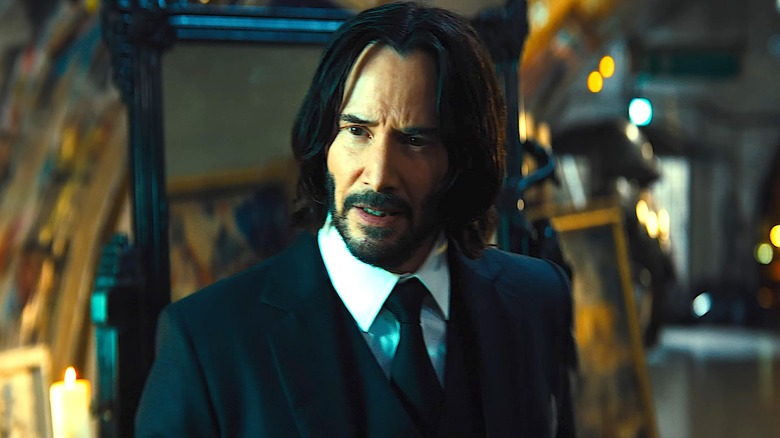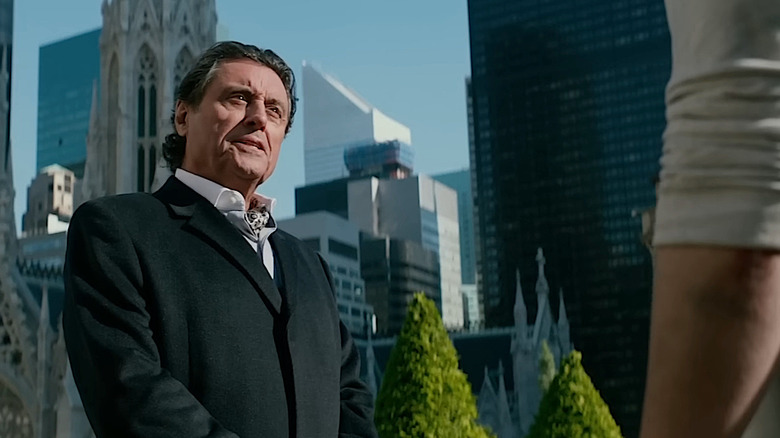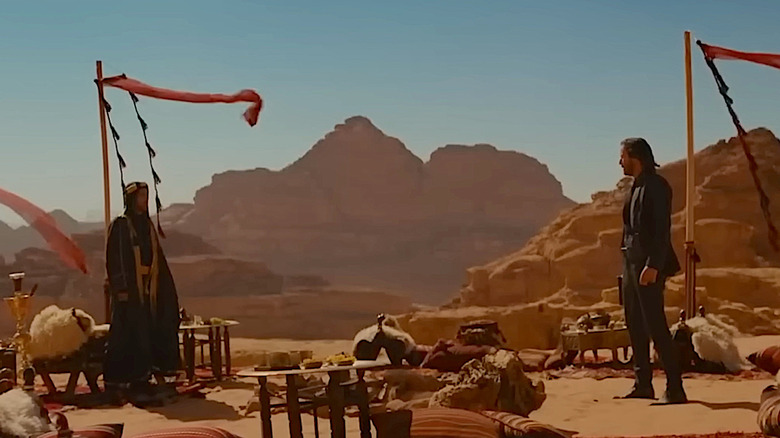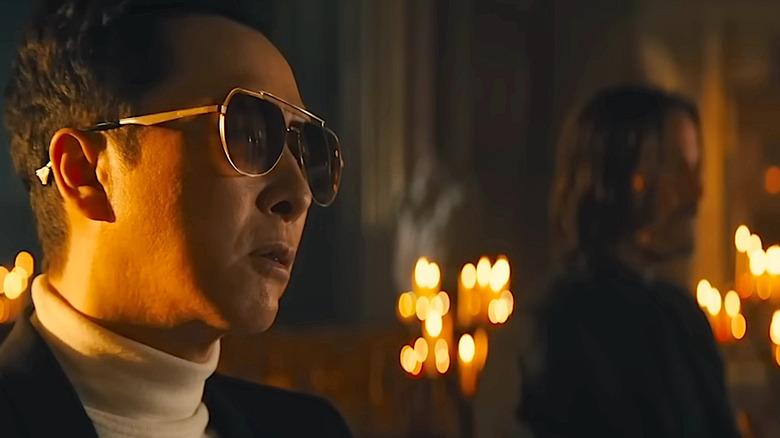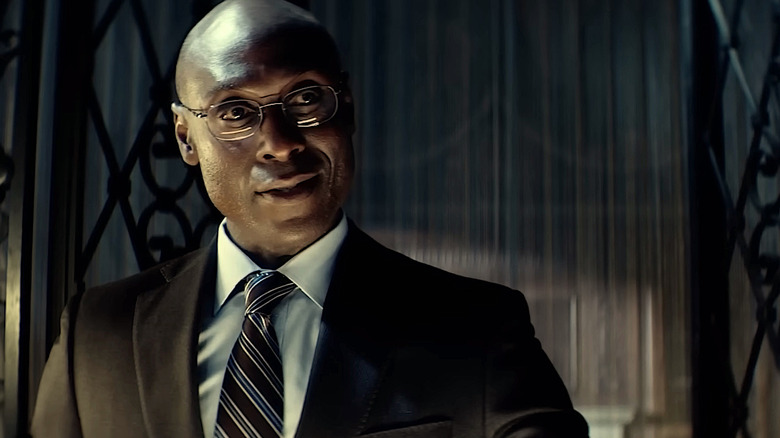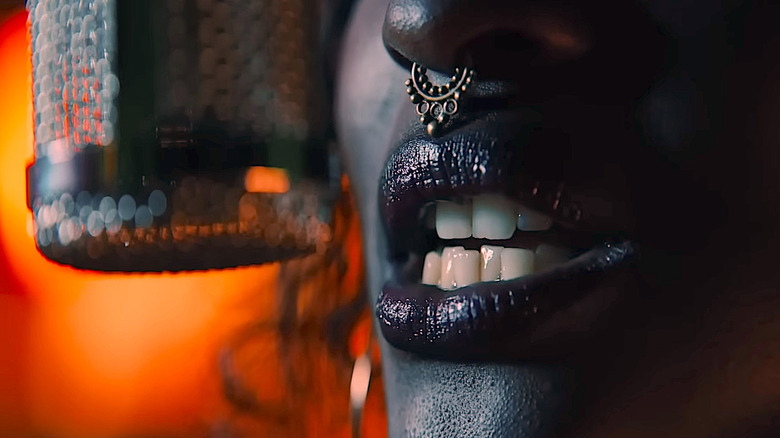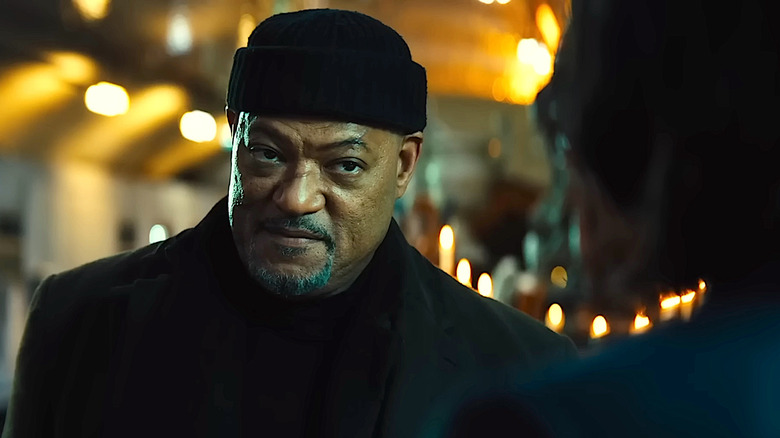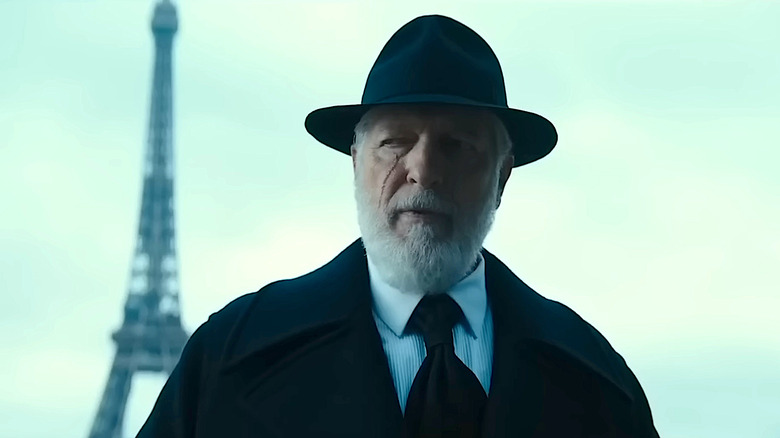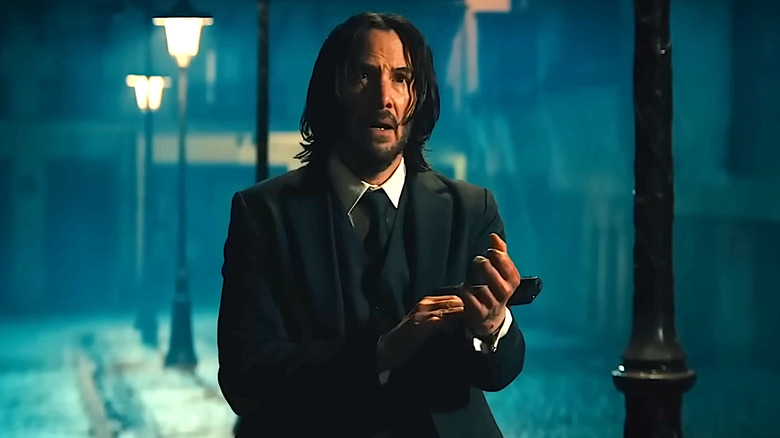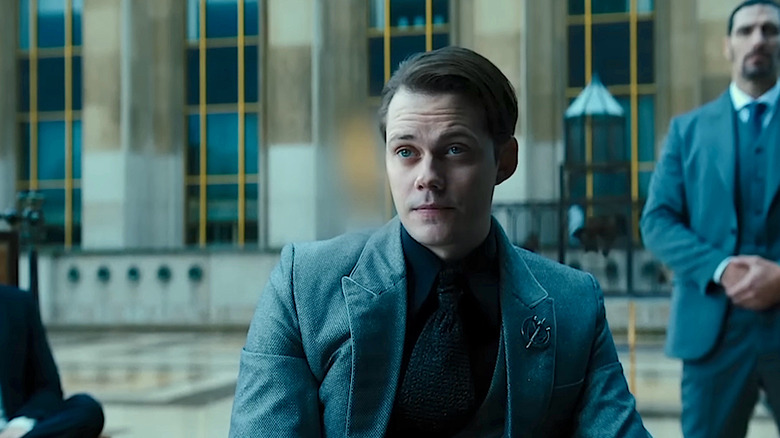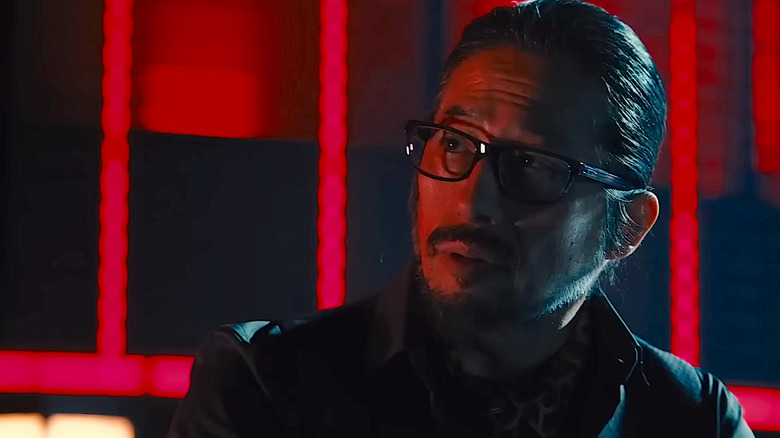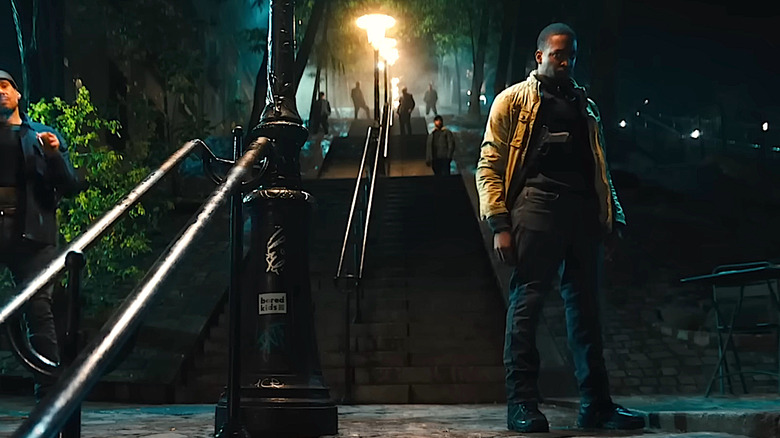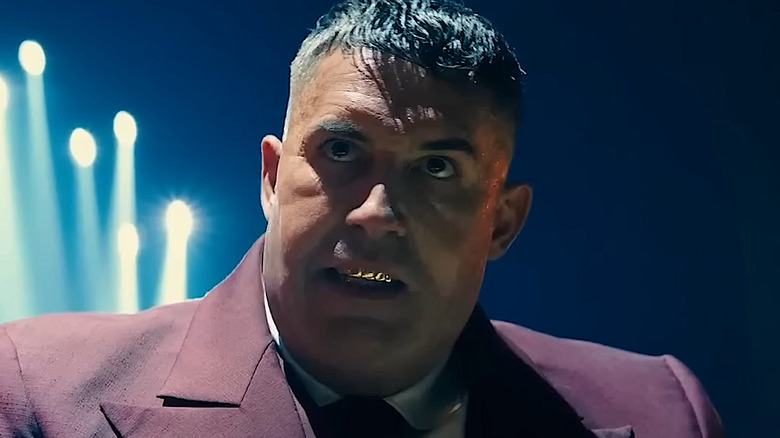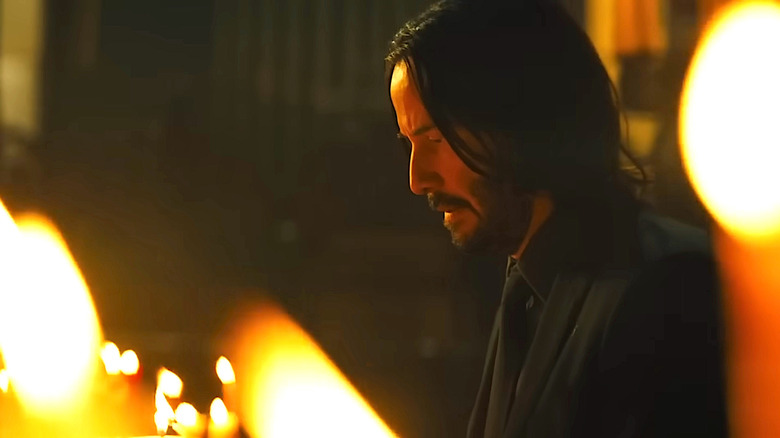John Wick 4's Most Confusing Moments Explained
"John Wick: Chapter 4" is the gutsy and glorious new installment of the ultimate grief-stricken action franchise. Epic in scope and operatic in approach, the latest film charges through battle after battle with the tenacity of John Wick (Keanu Reeves) himself and expects audiences to keep up.
Of course, "John Wick: Chapter 3 — Parabellum" was released four years ago, and while we understand if you're a little rusty on the lore that inspires the laws of the lawless, the "John Wick" filmmakers do not. Much like the High Table, the creative team behind these films doesn't suffer fools but does reward those who pledge their fealty and who think to refresh themselves on whose ticket was torn and what markers might be outstanding before they enter the movie theater.
Part of the fun of the "John Wick" universe is exploring the strict code of ethics that make or break all assassins all while keeping in mind that the High Table that sets those rules is clearly built on shifting sand. The latest installment keeps the stakes clear for each of John Wick's battles, but it also explores the idea of consequences for all of John Wick's actions up to this point. Whether your memory for rules is as vast as Winston's or as willfully ignorant of the details as John Wick's, join us in the desert on a horse with no name as we take a spoiler-filled ride through the most confusing moments of "John Wick: Chapter 4" explained.
Did Winston really mean to kill John Wick?
The shocking end of "John Wick: Chapter 3 — Parabellum" sees Winston shoot John Wick off the roof of the Continental. Even though Winston technically leaves John Wick for dead, the man is very much alive. When John sees Winston again in "John Wick: Chapter 4," he doesn't seem to have a problem with Winston. So when Winston shot John, was he really shooting to kill?
Winston (Ian McShane) knows the High Table doesn't pull its punches when it comes to consequential beatdowns, so it tracks that he really did try to kill John Wick to meet the demands of the Table. Of course, it also tracks that Winston knows his way around a bullet-proof suit and that John can both take a hit and fall off a building without going down for the count.
There is also a definite bond between the two men. Winston even seems paternal towards John at times, and not just because he bids farewell to "my son" at his actual gravesite. It makes us think he shot John Wick to save his life rather than end it — High Table be damned. For all of Winston's talk about rules being what keeps a man separate from the animals, he can't help being a man of instinct himself. While he defers to top dogs like the Adjudicator, Winston stops at nothing to protect the rest of his pack, even if he isn't always successful.
Why does John kill the new Elder?
John Wick sets out to strike down the High Table in "John Wick: Chapter 4." However, he doesn't start in New York, instead heading to Morocco where he chases down the new Elder. But why does John Wick kill this Elder? To answer, we must head back to "John Wick: Chapter 3 — Parabellum."
In the third installment of the "John Wick" franchise, John spends an eternity walking through the desert to find the Elder and un-excommunicado him. That Elder demands John's ring finger (the High Table really has a thing for fingers) in exchange for removing the price tag on his head. Now, John is back in the desert, ready to kill this replacement Elder for not being able to give him back the wedding ring the old Elder took. This new Elder doesn't know how to read the room (or the desert) and tells John he'll only know peace when he's dead. This leads to John killing him and sends the High Table (and the Marquis) into punishment hyperdrive.
While this kill shot sets off the events of the movie, it also speaks to the tragic arc of revenge. The Elder has been replaced by a new Elder. The Marquis will be replaced by a new Marquis. No matter how many Hydra heads or henchmen John Wick takes down, new ones will spring back up in their place, ready for a new fight with the same old John Wick.
Ding-Dong, Mr. Wick
Blind assassin Caine, played by action legend Donnie Yen, is pressed into service to the High Table by the manipulative Marquis de Gramont. Caine will do anything to keep his daughter alive, well, and playing violin in the public square — even if that means killing old friend John Wick. So how does he do this?
Okay, we admit, this is less a statement of confusion than it is an appreciation of Caine's creative and relentless fighting style. The slice of Caine's cane (yes, we see what you did there, Chad Stahelski) against metal and stone is a great sonic signifier of the pain he's about to rain down on his opponents. Caine's heightened sense of hearing helps him locate John Wick using the crunching glass in the gallery scene at the Osaka Continental. However, one of Caine's most unique techniques involves the use of cleverly placed doorbell sensors.
At first, it's puzzling to see Caine slap a bunch of electronic rectangles on various surfaces in the Osaka Continental's dark kitchen. It almost looks like he's setting bomb charges, but he isn't — he's just setting traps. When the Menpo-looking High Table stormtroopers invade the kitchen, they set off the doorbell sensors and give Caine a precise audible target. If WUXIA assassin radio was playing under this scene, we're sure it would have featured Anita Ward's "Ring My Bell."
What is the meaning of such is life?
The "John Wick" films are the stuff of legend and the films themselves are stuffed with symbolism pulled from Greek and Roman mythology. So why does Winston recall the mythic last words of a legendary Australian outlaw in what might be John Wick's last ride?
Winston tells Charon — portrayed by the late, great Lance Reddick – a story about Australian bandit Ned Kelly's words after learning when we would be executed: "Such is life." While the real Ned could have just been uttering the "meh" of his time, the words mean something to Winston. To Winston, Ned's acceptance of his fate is both noble and unsettling. Winston isn't ready to accept the fate handed to him and his beloved Continental from the High Table, nor is he accepting of John Wick going down without another fight.
Charon, however, utters the "Such is life" phrase to Winston before accepting his own fate. Even if we (and audiences) are shocked to see the Marquis finish Charon off, the moment makes Winston realize that the High Table will always take more than he can give. Winston's life itself is at stake as John's second. When John asks Winston for last words before the duel, Winston assumes the Charon role by assuring John whatever the outcome, "Such is life."
Killer radio station
What's a night at the battle ballet without music to kill for? In "John Wick: Chapter 4," we get to see "accountants" at work in new parts of the globe. Though the pink tattooed ladies in Osaka and Paris have their hands full changing the bounty board for John Wick along with many other small details, they still manage to sneak in a little light DJ work for the secret assassin equivalent of drive time radio.
In between dispatching John Wick's location to a horde of would-be Wick-killers, the DJ (Marie Pierra Kakoma) spins cheeky jams to score the numerous fights for John Wick's life. While previous installments in the "John Wick" franchise have mostly stuck to a driving score featuring rock, pop, EDM, and classical themes — plus the odd Kaleida needle drop — the assassin radio in "John Wick: Chapter 4" plays the hits for hit-people. Or rather, unspeakably stylish covers of them, like Lola Colette's cover of "Nowhere to Run" by Martha and The Vandellas.
Still, we have to ask — do all assassins get a bespoke butt-kicking soundtrack, or is this a special service reserved for Mr. Wick when he's at the Arc de Triomphe? Who else is in heavy rotation on the playlist? Murder By Death? Public Enemy? The Killers? Even if John Wick is the sole target of assassin radio's sonic stylings, we appreciate their approach — and the secretly meaningful WUXIA radio station call letters.
How did Bowery King get to Paris so fast?
Laurence Fishburne came to the "John Wick" franchise to chew scenery and chew gum, and guess what? He's fresh out of gum. While Fishburne doesn't have as much screen time in the latest installment as the ending of "John Wick: Chapter 3 — Parabellum" seemed to promise, Fishburne makes a delicious meal of every delectable line he has in "John Wick: Chapter 4." He also savors what appears to be the Bowery King's new superpower -– time travel.
How else can Bowery King zip from the bowels of New York City to the bowels of Paris so quickly? At the beginning of "John Wick: Chapter 4," we see Bowery King in the sewers of NYC. However, he pops up in Paris underground with a neatly pressed (bullet-proof) suit for John to do battle in practically at a moment's notice. Our money is on a time-traveling ace up Bowery King's sleeve — the Tick Tock Man (Jason Mantzoukas).
Tick Tock Man is conspicuously absent from the film, possibly because he was too wiped out from helping Bowery King teleport all over the world. Still, if time travel trickery isn't really at play, we wouldn't put it past the Soup Kitchen to have developed a network that connects all shadowy underworlds into one subterranean secret superhighway. As Bowery King says, when you cut a king, you better cut him to the quick — and when you need to get to Paris to help John Wick, you better get there quickly.
Why is the Harbinger missing a finger?
When Clancy Brown's "John Wick: Chapter 4" character, Harbinger, rolls up to the NYC Continental, he greets Charon with a grim look and is clearly ready to get down to business. While Harbinger is there to condemn the hotel on behalf of the High Table, we wonder -– why is he missing a finger? And why is that missing finger's nub suspiciously twinning with John Wick's?
Did Harbinger try (and fail) to get out of the High Table game, just like John Wick? Is there some other reason Harbinger needed to cut off a finger to prove his loyalty to the Table? Harbinger doesn't seem to take much pleasure in enforcing the rules, unlike the smugly evil Marquis. However, Harbinger also doesn't back down from his duties or try to get creative with some rules, unlike the seemingly dutiful but truly rebellious Winston. So what's the story? This man's backstory is one of the biggest unanswered questions in "John Wick: Chapter 4."
Harbinger's "secret" is all in his name. "Harbinger" is another word for a warning of what is to come. Harbinger is John Wick's Ghost of Christmas Yet to Come made flesh, here to show John Wick what he could become if he doesn't bring the High Table down or at least get out from under it. Harbinger was likely once an assassin just like John Wick and, judging from his joyless demeanor and imprisoned air, he and John Wick might have a deeper loss in common — even if we can't quite put our finger on what.
What is the deal with all the hand cutting?
The High Table is already highly sus, but what is with their bloodthirst when it comes to hands? Why do so many assassins have to cut off a finger or (in the Tracker's case) absolutely maim their hands to prove fealty to the High Table? Isn't damaging one of an assassin's two killing hands in a public pledge of devotion counterintuitive, not to mention just a bit much?
Honor among thieves comes at a high cost, and the rules of "John Wick" are the cost of doing business as a top-tier assassin. The order of John Wick's particular underworld is kept in check by intense rules and their known consequences. As Winston says, "Rules — without them, we'd live with the animals." While he might be right, the rules and their attendant consequences are also abused by High Table top brass like the smug and specious Marquis de Gramont.
Marquis de Shade
Bill Skarsgård plays the princely Marquis de Gramont in "John Wick: Chapter 4." He is obsessed with maintaining the supremacy of the High Table while wearing five-piece glitter suits. The smug scion agrees to John Wick's terms for an "old rules" duel then quickly begins to cheat. He ups the bounty on John Wick's head and sends his own assassins after him. The Marquis has endless riches at his disposal, but what's his story? Why does he have so much power and such little actual integrity?
The Marquis de Gramont represents the High Table and how its absolute power leads to absolute corruption. The Marquis worships the etiquette and ceremony of the High Table. He is happy to exact the pounds of flesh and pints of blood from those underneath him when they break the rules, but when it's his turn to face the music, the Marquis chooses a proxy to do this fighting for him and still tries to fix that fight.
The Marquis is a delicious villain and a cautionary tale. His power and that of the High Table is orderly but ultimately corrupt, superficial, and hollow. He shows the dangers of standing on ceremony instead of principal and favoring excessive shows of power over common sense development of skill, like, say, hand-to-hand combat — or even just counting shots. Though the Marquis worships some rules, he doesn't want to get his hands dirty for them.
Why does Shimazu fight for John Wick?
After John Wick kills his second Elder in four years (or about a week in movie time) he seeks refuge at Osaka's Continental. In the neon-lit night, John Wick and the surrounding sakura trees wait in the neon-lit night to get advice from yet another stern but loving assassin hotel manager, Shimazu Koji, played by action star Hiroyuki Sanada. But why?
"John Wick: Chapter 4" implies that John Wick, Shimazu, and Caine are old assassin friends. So why does Caine attack John Wick while Shimazu risks everything to protect him? The answer is simple and the embodiment of the Olive Garden slogan. For Shimazu, friendship is a matter of the heart. And when you're in his heart — you're family.
Caine draws the line between friend and family to protect his daughter. His daughter means more to him than his friendship with John Wick, and he doesn't defy the High Table (initially, anyway) because he knows the High Table will kill her if he doesn't kill John Wick. Shimazu, meanwhile, knows the Table will come for him and his daughter Akira (Rina Sawayama) merely for harboring John Wick in their hotel. Shimazu fights just as hard for John Wick as he does for his daughter. His choice to be loyal to his loved ones ultimately costs him his life. Considering that post-credits scene with Akira, it's possible that Caine's choices do the same for him.
Why does Mr. Nobody protect John Wick but try to kill him later?
The Tracker, Mr. Nobody, the other super-assassin with a pet Belgian Malinois – Shamier Anderson's "John Wick: Chapter 4" character operates under many names. The newcomer to the franchise is almost as mysterious as the Tracker character he plays in the fourth film, appearing out of nowhere as a fully-fledged adversary to Mr. Wick, but is this man with a plan (and a sketchbook) John Wick's friend or foe?
At first, Nobody appears to be yet another long-lost friend of Mr. Wick's emerging from the shadows to pledge his sword and attack dog. He fires a shot that saves John's life, but it isn't because he shares Shimazu's brotherly love for Mr. Wick. The Tracker is actually trying to drive the price up on Mr. Wick's head, not save it from rolling.
While we can totally see a universe where the Tracker and John buddy up — or even one where the Tracker finds a fistful of reasons to take up John Wick's fight against the High Table — by the end of the film, the Tracker has a $40 million payday to try and collect on instead of one for $20 million. That would pay for a whole lot of cargo pants, but why does he really need that much? Anderson tells Inverse it isn't the Tracker that needs the cash at all. "Not to give away too much, but it was for his mother."
Why does John have to kill the Killa?
There are two things the Marquis Vincent de Gramont loves more than anything in this world — sparkly suits and sending messages. The Marquis sends plenty of the latter after John Wick defies the High Table in "John Wick: Chapter 3 – Parabellum," including having Pyotr, leader of the Ruska Roma, killed to punish the crime family for getting excommunicado John Wick out of New York City and into Morocco.
Pyotr might not ring any bells with viewers. Although he is an off-camera adoptive father figure to John back in his Jardani Jovanovich days, it's Anjelica Huston's the Director character audiences that know from the third film. Still, the death of Pyotr has left a bad taste in the Ruska Roma family's mouth, and John's adoptive sister Katia won't help John by sponsoring his duel with the Marquis unless he kills an enemy of hers — Killa Harkan.
Killa (played by a barely-recognizable Scott Adkins) is the Berlin head of the High Table and the baddie who pulled the trigger on Pyotr. If John kills this Kingpin-esque boss, he gets branded back into the Roma family for a seat at the Table and a sanctioned shot at his freedom by way of dueling the Marquis.
Is John really dead?
Say it ain't so. The end of "John Wick: Chapter 4" sees John Wick dead and gone. At least, it looks that way. After taking hit after hit and stair fall after stair fall, John Wick seems to meet his end on the steps of Sacré-Coeur. He slumps to his side in the sunrise. He has a vision of the wife he lost, and truly seems to have drawn his last breath.
Later, Bowery King and Winston visit John's grave. He's buried next to his wife, and even though Bowery King and Winston seem a little lighthearted with their farewells, John's stone is inscribed as he requested. So is this a clever set-up for an impossible beginning in "John Wick 5" or is this the end?
The "John Wick" movies are such stunning spectacles that it's easy to forget how much effort, time, and talent they take to make. Four years passed between the release of "John Wick: Chapter 3" and its follow-up film. Keanu Reeves and Chad Stahelski have plenty on their plates aside from the world of Wick. The collaborators have been working together in one way or another since their days on "The Matrix." Who knows what their creative partnership might yield if this is the end of John Wick's road? Though the character might make appearances in the "Ballerina" spin-off, everyone's favorite dog-avenging, grief-stricken loving husband might really be gone for good. Such is life.
